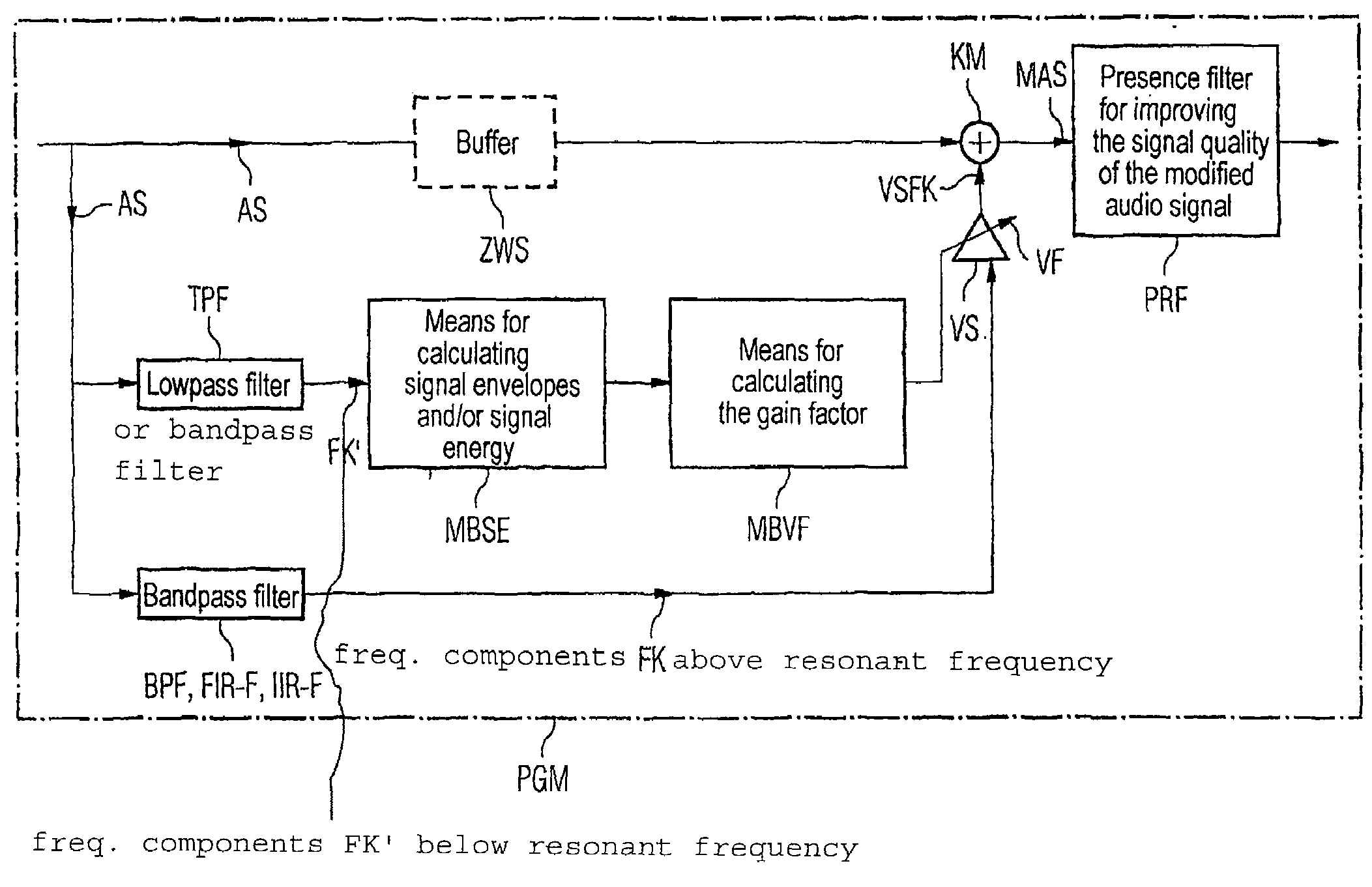Method and apparatus for controlling the reproduction in audio signals in electroacoustic converters
a technology of electroacoustic converter and audio signal, which is applied in the direction of tone control, transducer casing/cabinet/support, electrical transducer, etc., can solve the problems of unsatisfactory base reproduction and achieve the effect of avoiding distortion of audio signal, reducing requirements, and improving the quality of modified audio signals
- Summary
- Abstract
- Description
- Claims
- Application Information
AI Technical Summary
Benefits of technology
Problems solved by technology
Method used
Image
Examples
first embodiment
[0024]FIG. 4 shows the program module PGM in accordance with FIG. 2. The audio signal AS is bandpass filtered using a bandpass filter implemented by software BPS to isolate a first frequency component FK, and is filtered via a low pass filter TPF implemented by software to isolate a second frequency component FK′. While the first frequency component FK is being amplified, a gain factor VF determined by the amplification of the first frequency component FK is generated with the second frequency component FK′.
[0025]Instead of the low pass filter TPF, a further bandpass filter implemented via software can be used as an alternative, or even the bandpass filter which the first frequency component FK generates. In the latter case, the two frequency components FK, FK′ would be the same (FK=FK′).
[0026]The bandpass filter BPF is preferably embodied as a Finite Impulse Response filter (FIR filter) FIR-F or, alternatively, as an Infinite Impulse Response filter (IIR filter) IIR-F. If the bandp...
second embodiment
[0028]FIG. 5 uses FIG. 4 as a starting point to show program module PGM in accordance with FIG. 2. The audio signal AS is again bandpass filtered with the bandpass filter BPF for isolation of the first frequency component FK and lowpass filtered with the lowpass filter TPF for isolation of the second frequency component FK′. While the first frequency components FK is again being amplified, a gain factor VF determined by the amplification of the first frequency component FK is again generated with the second frequency component FK′.
[0029]Instead of the lowpass filter TPF, a further bandpass filter implemented via software again can be used as an alternative, or even the bandpass filter which the first frequency component FK generates. In the latter case, the two frequency components FK, FK′ would then again be the same (FK=FK′).
[0030]The bandpass filter BPF is again preferably embodied as a Finite Impulse Response filter (FIR filter) FIR-F or, alternatively, as an Infinite Impulse Re...
third embodiment
[0034]FIG. 6 uses FIG. 4 as a starting point to show program module PGM in accordance with FIG. 2. The audio signal AS is once more bandpass filtered with the bandpass filter BPF for isolation of the first frequency component FK and low pass filtered with the low pass filter TPF for isolation of the second frequency component FK′. While the first frequency component FK is being amplified, a gain factor VF determined by the amplification of the first frequency component FK is once again generated with the second frequency component FK′.
[0035]Instead of the lowpass filter TPF, a further bandpass filter implemented via software again can be used as an alternative, or even the bandpass filter which the first frequency component FK generates. In the latter case, the two frequency components FK, FK′ would be the same (FK=FK′).
[0036]The bandpass filter BPF is once more preferably embodied as a Finite Impulse Response filter (FIR filter) FIR-F or, alternatively, as an Infinite Impulse Respo...
PUM
 Login to View More
Login to View More Abstract
Description
Claims
Application Information
 Login to View More
Login to View More - R&D
- Intellectual Property
- Life Sciences
- Materials
- Tech Scout
- Unparalleled Data Quality
- Higher Quality Content
- 60% Fewer Hallucinations
Browse by: Latest US Patents, China's latest patents, Technical Efficacy Thesaurus, Application Domain, Technology Topic, Popular Technical Reports.
© 2025 PatSnap. All rights reserved.Legal|Privacy policy|Modern Slavery Act Transparency Statement|Sitemap|About US| Contact US: help@patsnap.com



